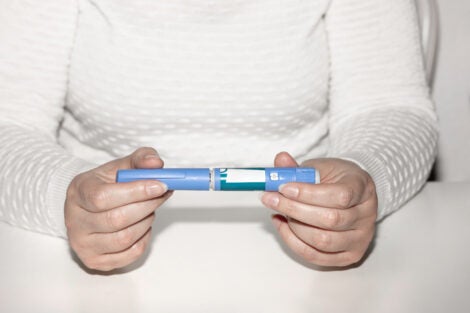For immediate release: December 11, 2023
Boston, MA—Infants born to women with pre-gestational type 2 diabetes who take second-line non-insulin antidiabetic medications (ADMs) during pregnancy are at no higher risk of major congenital malformations (MCMs) than infants born to those who take insulin, according to a new study led by Harvard T.H. Chan School of Public Health. While MCMs, including major cardiac malformations, are more prevalent among infants born to women with pre-gestational diabetes, the researchers observed no differences in risk between infants whose mother treated her diabetes with insulin versus with non-insulin second-line ADMs.
The study also found an increase in use of second-line non-insulin ADMs throughout the study period, especially use of GLP-1 receptor agonists in the U.S., suggesting the number of infants prenatally exposed to these drugs will continue to increase.
The study was published on December 11, 2023, in JAMA Internal Medicine. It is the first large study to examine the potential risks second-line non-insulin ADMs pose to fetal development in humans.
“As type 2 diabetes becomes a more common condition among women of reproductive age, and with the recent approval of GLP-1 receptor agonists such as semaglutide to treat obesity, the number of exposed pregnancies is likely to increase. Our findings provide initial reassurance of safety for infants prenatally exposed to these medications,” said first author Carolyn Cesta, assistant professor at Karolinska Institutet in Sweden.
Using health databases in Finland, Iceland, Norway, Sweden, the United States, and Israel, the researchers examined the outcomes of more than 3.5 million pregnancies between 2009 and 2021. Among these pregnancies, 51,826 (1.5%) comprised the study group of women with pre-gestational type 2 diabetes. In the periconceptional period—between three months before and three months after conception—15,148 (29.2%) of these individuals filled a prescription for a first- or second-line ADM.
The study found that infants whose mother had pre-gestational type 2 diabetes had a substantially higher prevalence of MCMs, including cardiac malformations, compared with infants in the general population. Within the study population of women with type 2 diabetes, 5.58% of infants were born with an MCM and 2.25% were born with a cardiac malformation, compared to 3.76% and 1.31%, respectively, of infants born to the general population. However, within infants born to women with diabetes who took second-line non-insulin ADMs—sulfonylureas, DPP-4 inhibitors, GLP-1 receptor agonists, or SGLT2 inhibitors—the study did not find a greater risk of MCMs after periconceptional exposure compared with infants exposed to insulin.
The researchers noted that some of the study’s findings were imprecise, and that continuous monitoring and further research will provide more precise risk estimates.
“As more and more parents and their health care providers search for evidence on the safety of these medications, our research can help inform their decisions,” said senior author Sonia Hernández-Díaz, professor of epidemiology at Harvard Chan School.
The study was funded by the National Institute of Child Health and Development (grant R01 HD097778); the European Union’s Horizon 2020 research and innovation program (grant 844728); NordForsk Nordic Program on Health and Welfare (Nordic Pregnancy Drug Safety Studies, project no. 83539); the Research Council of Norway (International Pregnancy Drug Safety Studies, project no. 273366); and the Research Council of Norway’s Centres of Excellence (project no. 262700).
“Safety of GLP-1 receptor agonists and other 2nd-line antidiabetics in early pregnancy: an international cohort study,” Carolyn E. Cesta, Ran Rotem, Brian T. Bateman, Gabriel Chodick, Jacqueline M. Cohen, Kari Furu, Mika Gissler, Krista F. Huybrechts, Lars J. Kjerpeseth, Maarit K. Leinonen, Laura Pazzagli, Helga Zoega, Ellen W. Seely, Elisabetta Patorno, Sonia Hernández-Díaz, JAMA Internal Medicine, December 11, 2023, doi: 10.1001/jamainternalmed.2023.6663
Visit the Harvard Chan School website for the latest news, press releases, and multimedia offerings.
Image: iStock/CR
For more information:
Maya Brownstein
mbrownstein@hsph.harvard.edu
###
Harvard T.H. Chan School of Public Health brings together dedicated experts from many disciplines to educate new generations of global health leaders and produce powerful ideas that improve the lives and health of people everywhere. As a community of leading scientists, educators, and students, we work together to take innovative ideas from the laboratory to people’s lives—not only making scientific breakthroughs, but also working to change individual behaviors, public policies, and health care practices. Each year, more than 400 faculty members at Harvard Chan School teach 1,000-plus full-time students from around the world and train thousands more through online and executive education courses. Founded in 1913 as the Harvard-MIT School of Health Officers, the School is recognized as America’s oldest professional training program in public health.
